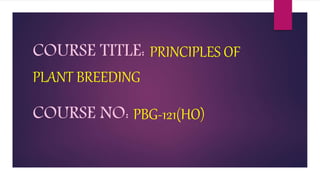
Presentation on Recurrent Selection
- 1. COURSE TITLE: PRINCIPLES OF PLANT BREEDING COURSE NO: PBG-121(HO)
- 2. RECURRENT SELECTION The initial idea of recurrent selection was independently given by Hayes and Garber in 1919 and East and Jones in 1920. But the term recurrent selection was first coined by Hull in 1945.
- 3. Definition: Recurrent selection is defined as reselection generation after generation, with intermating of selected plant to produce the population for the next cycle of selection. The idea of this method was to ensure the isolation of superior inbreds from the population subjected to recurrent selection. The isolation of an outstanding inbred line depends on two factors: 1) The proportion of superior genotypes present in the base population from which
- 4. MAIN FEATURES: Application : recurrent selection was originally developed as a method of breeding of cross pollinated species . Now it is also used in self pollinated species. Base population: A heterozygous base population is required to start recurrent selection. In cross pollinated species, a base population may be either of the five populations, viz.(a)an open pollinated variety,(b)a synthetic variety,(c)progeny of intercrosses among selected inbreds,(d)a double cross,and (e)a single cross.
- 5. TYPES OF RECURRENT SELECTION These are four types of recurrent selection. 1. Simple recurrent selection (SRS). 2. Recurrent selection for general combining ability (RSGCA) . 3. Recurrent selection for specific combining ability (RSSCA). 4. Reciprocal recurrent selection (RRS)
- 6. Simple Recurrent Selection (SRS) : A type of recurrent selection that does not include tester is referred as simple recurrent selection. It is also known as phenotypic recurrent selection. Procedure of Simple RecurrentSelection: 1) A number of plants with desirable phenotype are selected and self- pollinated in the 1st year.2) In the second year separate progeny rows are grown from selfed seed of the selected plants.3) The progenies are inter crossed in all possible combination by hand.4) Equal amount of seed from each cross is composited to produce the next generation. This complete the original selection cycle.
- 8. 5) In the third year, bulked seeds are grown and superior plants are selected and selfed, like first year. 6) In the fourth year, progeny of selected plants are grown from selfed seed and intermating is done like first year. 7) The crossed seed is composited in equal quantity for use in the next cycle of selection. This complete first cycle of simple recurrent selection. Thus selection cycles may be repeated till the desired improvement is achieved. Recurrent Selection for General Combining Ability (GCA): A form of recurrent selection used to important the general combining ability of a population for a character and the heterozygous tester is referred as RSGCA. It is also known as half sub recur selection.
- 9. Recurrent Selection for SCA: It was originally proposed by Hull in 1945, a form of recurrent selection that is used to improve the SCA of a population for a character by using homozygous tester is referred as (RSSCA) recurrent selection for specific combining ability. It is also known as half site recurrent selection with homozygous tester. Reciprocal Recurrent Selection (RRS): A form of recurrent selection used to improve both GCA and SCA of a population for a character using two heterozygous testers is known as RRS. It is also known as recurrent reciprocal half sib selection. Comstock et al in 1949, proposed this method.
- 11. Merits: 1) Recurrent selection is an efficient breeding method for increasing the frequency of superior genes for various economic characters.2) It helps in breaking repulsion phase of linkage.3) It helps in maintaining high genetic variability due to repeated intermating of heterozygous population. Demerits: 1) It is not directly used for the development of new varieties. 2) This method involves lot of selection crossing and selfing work. 3) It permits selfing , which leads to loss of genetic variability.
- 12. CONCLUSION: Recurrent selection is a cyclic selection that is used to improve the frequency of desirable alleles for a character in a breeding population. In other words it is an important method of population improvement.
- 13. SUBMITTED TO: Dr KAUSHIK PANIGRAHI SUBMITTED BY: SHUBHRANKSHI PRIYADARSHINI ADMISSION NO: 33HO/16
